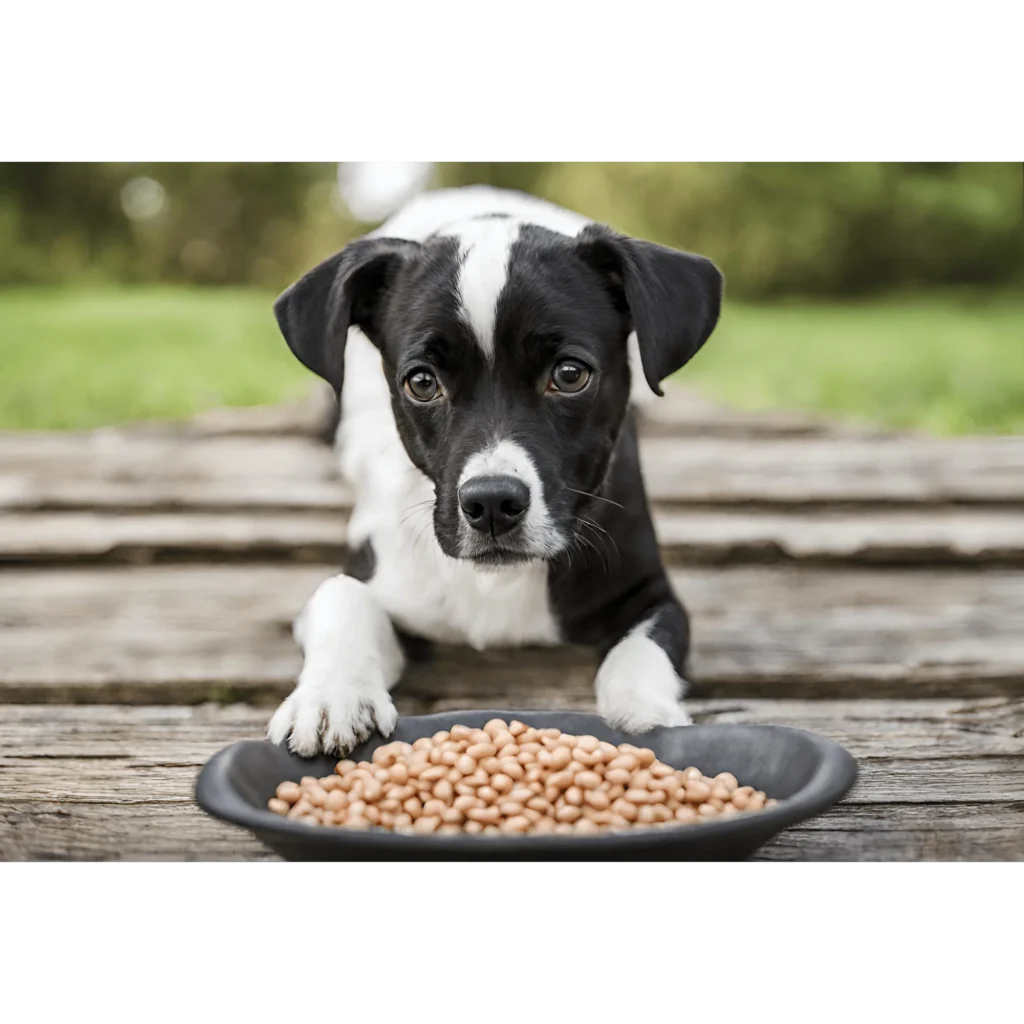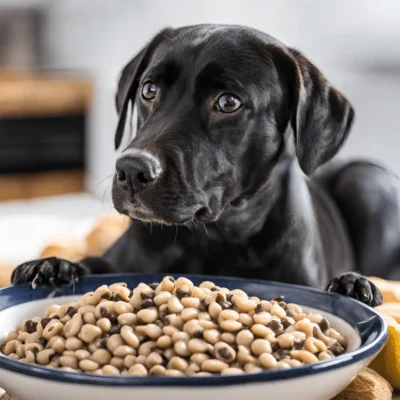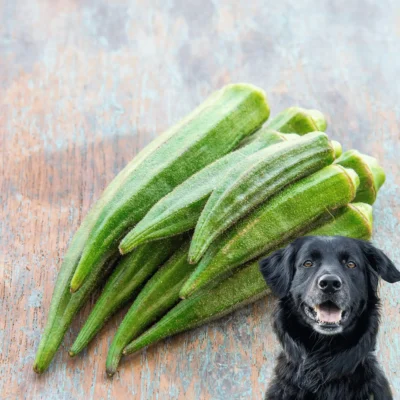Black-eyed peas are a fantastic addition to any meal, offering a mix of protein, fiber, and delightful flavor. But can dogs eat black-eyed peas? Yes, they can. However, before introducing this legume to your furry friend, it’s crucial to consider their preferences and potential allergies. There are also some essential things to know before offering black-eyed peas to your dog for the first time. For the well-being of your pet, consulting with their veterinarian is advisable before incorporating black-eyed peas into their diet.
In this article, we will delve into whether dogs can safely consume black-eyed peas. We will explore five health benefits and also be aware of potential risks. Additionally, we will learn how to prepare black-eyed peas for dogs.
Here are the topics we’re going to discuss in this blog post:
- What are black-eyed peas?
- Can dogs eat black-eyed peas?
- 5 health benefits of black-eyed peas for dogs
- Potential risk of black-eyed peas for dogs
- Can dogs eat canned black-eyed peas?
- Can dogs eat dried black-eyed peas?
- How do you prepare black-eyed peas for dogs?
What are Black Eyed Peas?

Black-eyed peas, also known as cowpeas, are a type of legume cultivated for their edible seeds. They belong to the Vigna genus and are a subspecies of the cowpea. These peas are small, cream-colored beans with a distinctive black or dark “eye” at their inner curve.
Resembling small, dark green beans, they possess an earthy flavor that can enhance or alter the taste of a dish depending on the accompanying ingredients.
Their flavor profile shines when cooked with ingredients such as tomatoes or onions. Alternatively, they can be enjoyed fresh, available at local grocery stores alongside other vegetables like green beans, spinach, and carrots. If not, relish them in their raw state, sprinkled with salt and pepper.
Can Dogs Eat Black Eyed Peas?
Yes, dogs can generally eat black-eyed peas in moderation. Dogs can enjoy black-eyed peas, also known as goat peas, as an occasional treat. These peas are a good source of plant-based protein, fiber, and essential vitamins and minerals. However, it’s important to prepare them plain and without any added seasonings, spices, or other ingredients that might be harmful to dogs.
To maintain a well-balanced diet for your dog, comprising carbohydrates, protein, and vegetables, introduce black-eyed peas in moderation. Treats should account for no more than ten percent of your dog’s daily calorie intake. Excessive consumption of black-eyed peas may result in gassiness or stomach upset for your pet.
As with any new food introduced into a dog’s diet, monitoring for any signs of allergies or digestive upset is crucial. Additionally, always consult with your veterinarian before making significant changes to your dog’s diet, especially if your dog has existing health conditions or dietary restrictions.
5 Health Benefits of Black Eyed Peas for Dogs:

Black-eyed peas can offer several health benefits for dogs when included as part of a balanced diet. Here are five potential health perks:
1. High in Protein:
Black-eyed peas are an excellent source of protein, contributing to the development of healthy muscles in your dog. Introducing black-eyed peas alongside the animal proteins in commercial dog food can offer a well-rounded and nutritious meal for your furry companion.
This combination ensures that your dog receives a diverse range of nutrients to support their overall health and well-being.
2. Vitamins and Minerals:
Black-eyed peas offer various vitamins and minerals, including folate, potassium, vitamin A, vitamin C, iron, and magnesium. Folate is necessary for cell division and the formation of DNA. It plays a role in synthesising red blood cells, and a deficiency can lead to anemia.
Potassium, an essential mineral, plays a pivotal role in regulating fluid balance, nerve signals, and muscle contractions. Meanwhile, vitamin A is crucial for vision, immune system function, and skin health.
While dogs can produce their own vitamin C, dietary sources can still contribute to antioxidant activity. Vitamin C is important for collagen formation, wound healing, and immune system support.
Iron stands as a crucial component of hemoglobin, the protein responsible for transporting oxygen in the blood. Similarly, magnesium plays a vital role in various physiological processes, encompassing energy production, muscle function, and bone health.
3. Rich in Fiber:
The fiber in black-eyed peas can promote digestive health in dogs by supporting regular bowel movements. Adequate fiber intake helps prevent constipation and diarrhea, contributing to a healthy gastrointestinal system.
The presence of fiber can help dogs feel fuller for longer periods, potentially assisting in weight management by reducing overall food consumption. This can be beneficial for dogs prone to weight issues or obesity.
Fiber plays a role in regulating blood sugar levels. By slowing down the absorption of sugars, it can contribute to more stable blood sugar levels, which is particularly important for dogs with diabetes or those at risk of developing it.
4. Low in Fat:
Indeed, black-eyed peas are relatively low in fat, presenting a potential benefit for dogs, especially those with specific health conditions like pancreatitis. Pancreatitis involves inflammation of the pancreas, and a low-fat diet is commonly recommended to alleviate the pancreas’s workload and minimize the risk of flare-ups.
For dogs, a diet excessively high in fat may lead to digestive problems, including diarrhea or stomach upset. Choosing low-fat foods like black-eyed peas can contribute to maintaining healthy digestion in dogs, offering a suitable dietary option for those with specific health considerations.
5. Antioxidant Properties:
Black-eyed peas are rich in antioxidants, which play a crucial role in safeguarding cells from oxidative stress. This protection is important for maintaining cellular health and reducing the risk of cell damage and inflammation.
Antioxidants neutralize free radicals and unstable molecules that can harm cells and contribute to various health issues. Antioxidants contribute to skin and coat health by protecting cells from damage. This can result in a healthier, shinier coat and may benefit dogs with skin conditions.
Potential Risks of Black-Eyed Peas for Dogs:

While black-eyed peas can offer some nutritional advantages for dogs, there are also potential risks associated with their consumption. It’s important to be aware of these perils and take precautions when including black-eyed peas in your dog’s diet.
1. Digestive Upset:
Dogs may experience digestive upset, including diarrhea or stomach discomfort, if new foods are introduced too quickly into their diet. Improperly prepared black-eyed peas or undercooked legumes may be more challenging for dogs to digest, potentially leading to digestive upset.
Gradually incorporate black-eyed peas into your dog’s diet, starting with small amounts. Monitor for any signs of digestive issues and increase the quantity slowly over time. Ensure that the black-eyed peas are cooked thoroughly before feeding them to your dog. This helps break down complex compounds and makes the peas easier to digest.
2. Seasonings and Additives:
Many commercially available canned or pre-packaged black-eyed peas may contain added salt, which can be harmful to dogs in excessive amounts. High sodium intake can lead to issues such as increased thirst, urination, and, in severe cases, sodium ion poisoning.
Choose plain, unsalted black-eyed peas, and avoid canned varieties with added salt or seasoning. If using canned black-eyed peas, rinse them thoroughly to reduce the sodium content.
3. High fiber content:
The fiber content in black-eyed peas may be too high for some dogs, leading to digestive discomfort, flatulence, or changes in bowel movements.
Start with a small amount of black-eyed peas and monitor your dog’s response. If digestive issues arise, reduce the quantity or avoid feeding them to your dog.
4. Phosphorus Content:
Black-eyed peas contain phosphorus, and excessive phosphorus intake can be a concern for dogs with certain health conditions, such as kidney issues.
If your dog has specific health concerns, consult with your veterinarian to determine if black-eyed peas are a suitable addition to their diet.
5. Sensitivities and Allergies:
Some dogs may have individual sensitivities or allergies to specific foods, including legumes like black-eyed peas.
Monitor your dog for signs of allergies, such as itching, redness, or gastrointestinal upset, when introducing black-eyed peas. If any adverse reactions occur, discontinue feeding them and consult with your veterinarian.
Can Dogs Eat Canned Black-Eyed Peas?

Dog owners must exercise caution when offering canned black-eyed peas to their pets. The high salt content in canned varieties can be detrimental to dogs, potentially causing health issues. Therefore, it’s advisable to thoroughly rinse canned black-eyed peas before feeding them to your dog to reduce the salt content.
Additionally, providing black-eyed peas to dogs regularly may pose challenges to their digestive system. Like any new food, it’s recommended to introduce them gradually into your dog’s diet and monitor for any signs of digestive upset. If you notice any adverse reactions, it’s best to consult with your veterinarian to ensure your dog’s dietary needs are met without causing discomfort or health issues.
Can Dogs Eat Dried Black-Eyed Peas?

Dogs should not consume dried black-eyed peas without being properly cooked. The best way to prepare black-eyed peas for dogs is to cook them thoroughly. You can achieve this by heating a pot of water on the stove and gently simmering the peas until they become tender.
Properly cooked black-eyed peas can indeed serve as a special treat for your pet, providing them with a tasty and nutritious addition to their diet. Ensuring that the peas are cooked soft makes them easier for your dog to digest, reducing the risk of any digestive issues. Always consider your dog’s preferences and any dietary restrictions they may have before introducing new treats or foods into their diet.
How Do You Prepare Black-Eyed Peas for Dogs?

To seamlessly incorporate black-eyed peas into your dog’s diet, follow these steps:
1. Choose the Right Beans:
Start with fresh or dried black-eyed peas. Canned beans, often containing added sodium, preservatives, and seasonings, should be avoided to prevent stomach upset or dehydration. Opt for rehydrated dried black-eyed peas, thawed frozen beans, or fresh beans.
2. Cooking Process:
Black-eyed peas cook swiftly. Black-eyed peas have a quick cooking time compared to other dried beans. Unlike some varieties that need overnight soaking, you can add black-eyed peas directly to boiling water and simmer them until tender.
Typically, this process takes about thirty to fifty minutes, making them a convenient option for both human and canine consumption.
3. Allow Cooling Time:
Once you’ve cooked the black-eyed peas, it’s important to allow them to cool for at least fifteen minutes before serving them to your pet.
This cooling period helps ensure that the peas are at a safe and comfortable temperature for your dog to consume, reducing the risk of any potential burns or discomfort.
4. Experiment with Presentation:
Experimenting with various forms of black-eyed peas can help you determine your dog’s preferred way of enjoying them. You can offer the peas whole, mash them into a paste, or blend them with other dog-friendly ingredients.
This flexibility allows you to cater to your pet’s preferences and ensure they find the presentation most appealing. Observing how your dog responds to different forms of black-eyed peas can add variety to their diet and make mealtime an enjoyable experience.
5. Skip Seasoning:
Dogs’ digestive systems are sensitive to many seasonings. Avoid using salt, as excessive amounts can lead to ion poisoning.
Onions and garlic are toxic to dogs, and spicy seasonings like jalapeños or cayenne can cause stomach irritation, bloating, or vomiting. Keep black-eyed peas unseasoned to prevent any digestive issues in your dog.
Conclusion:
In conclusion, while black-eyed peas can offer valuable health benefits for dogs, responsible and informed feeding practices are paramount. The inclusion of these legumes in your dog’s diet should be approached with moderation, mindful preparation, and a keen awareness of potential risks. The rich protein content, essential vitamins, minerals, and antioxidant properties make goat peas a nutritious treat for your furry friend, promoting overall well-being.
However, the potential for digestive upset, high fiber content and the risks associated with seasonings or additives necessitate caution. By adhering to proper cooking methods, avoiding harmful additives, and consulting with a veterinarian when in doubt, you can ensure that black-eyed peas become a safe and enjoyable addition to your dog’s diet.
Always prioritize your pet’s health and tailor their dietary choices to meet their individual needs, recognizing that a well-balanced and carefully monitored approach contributes to a happy and healthy canine companion.
FAQs:
1: How do you cook black-eyed peas for dogs?
Choose fresh or dried peas over canned ones. Cook in boiling water for 30-50 minutes until tender. Skip seasonings, cool before serving, and experiment with different presentations to suit your dog’s preference. Avoid added salt or harmful seasonings for a safe and enjoyable treat.
2: What peas can dogs eat?
Dogs can safely enjoy various peas, including green peas, sugar snap peas, snow peas, and properly cooked plain black-eyed peas. When introducing new foods, do so gradually and closely monitor for any potential adverse reactions in your furry friend.
3: Are black-eyed peas safe for dogs?
Yes, black-eyed peas are generally safe for dogs when prepared plain and in moderation. They offer plant-based protein, fiber, and essential vitamins. However, avoid additives like salt or seasonings. Introduce gradually, monitor for allergies or digestive issues, and consult your vet, especially if your dog has dietary restrictions or health conditions.
4: What nutritional benefits do black-eyed peas offer for dogs?
Black-eyed peas provide plant-based protein, fiber, and essential vitamins and minerals, contributing to overall canine health.
5: What makes black-eyed peas potentially toxic for dogs?
The potential for toxicity arises when peas are seasoned with harmful additives, spices, or excessive salt. Dogs should not consume seasoned or spiced black-eyed peas.












